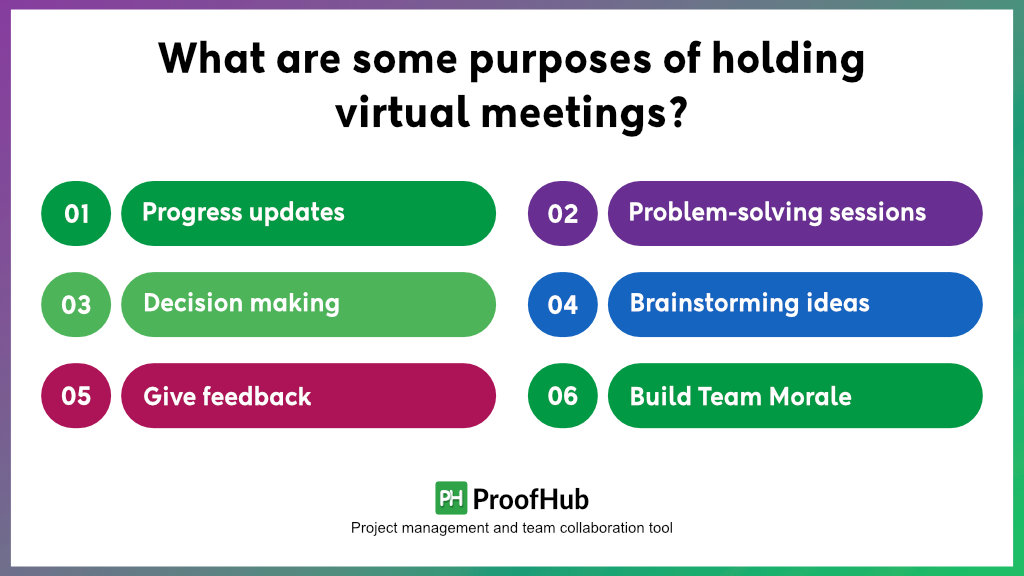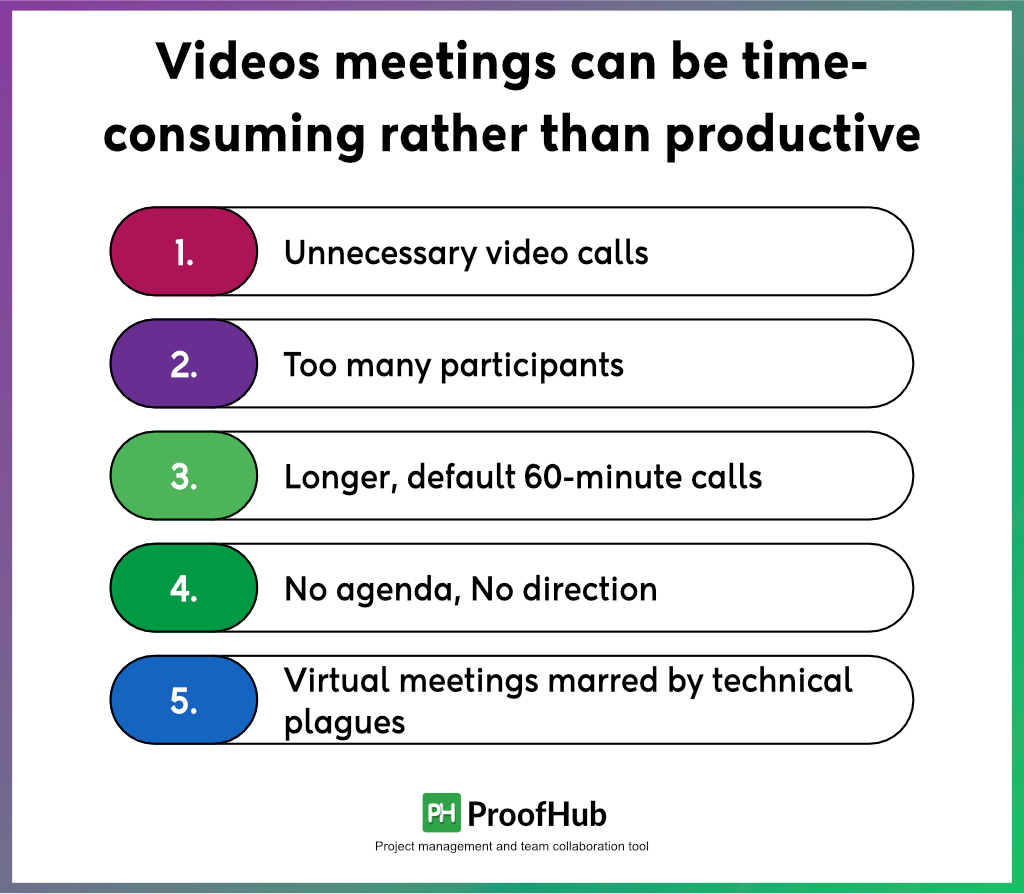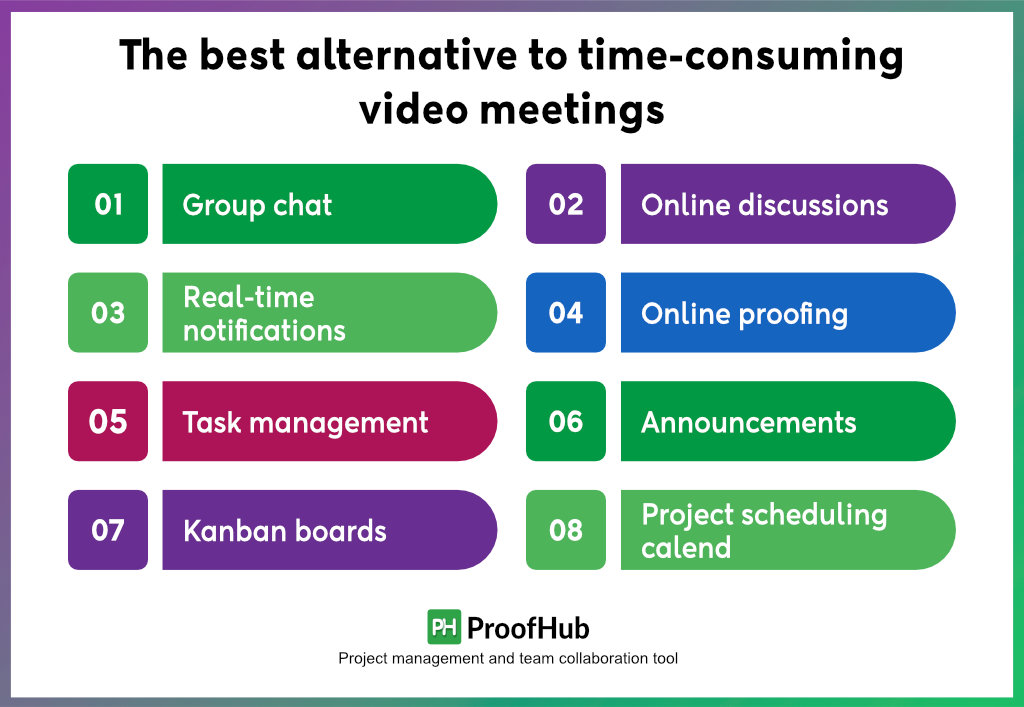It seems that remote work and video conferencing have become synonymous with each other. I’m assuming that you are one of several millions of people who are working remotely now after the global pandemic of COVID-19 threw normal life out of gear in various countries in the first quarter of 2020.
As remote work became a new normal, it posed a new set of challenges for employees, managers, and business owners who had to deal with this abrupt change for the first time in their professional careers.
One of the most important changes that has happened while businesses transitioned from regular office spaces to remote work is the way team meetings are scheduled now.
Face-to-face, in-person meetings held inside the office have been replaced by virtual team (and individual) meetings where participants interact with each other via video conferencing tools from their respective locations.
Since regular meetings are considered as an essential fixture to provide the latest updates regarding work, virtual meetings became inevitable.
However, it seems as if a large number of project managers and teams are using video meetings much more frequently than required. Virtual meetings have overshadowed other ways of communication due to the additional visual advantage they offer to participants.
Whether virtual or real-world, frequent meetings have been considered counterproductive as a lot of valuable time is wasted in these meetings over trivial issues.
I also believe that one of the main reasons why video meetings are being excessively used is that many managers and business owners do not trust their remote teams. They feel that due to the lack of direct supervision, they need to check in frequently to maintain greater control over remote workers.
There’s no cure for a mental illness called suspicion, I guess.
Other than that, there are some other justified purposes for scheduling video meetings. Most of these purposes, however, can be achieved by trying other smart alternatives to video meetings.
Before we move on to discuss other alternatives, let’s shed some light on some common purposes of holding remote meetings.
What are some purposes of holding virtual meetings?
The purposes of holding virtual meetings and face-to-face, in-person meetings in regular offices are no different from each other.

Let’s take a look at what necessitates remote teams to schedule video meetings often.
Progress updates
One of the most common purposes of holding virtual meetings is that managers and team leaders want to get daily updates from team members regarding their current work status.
Daily progress updates help project managers to know what every team member is working on, and if they are progressing at the right pace, or if some members are kind of stuck due to some issues, taking more than expected time to get the job done.
Problem-solving sessions
Since in-person discussions are not possible in a remote work environment, video meetings are the only way to solve a problem in the workplace. Problems are part of any project and they can affect your project’s progress, employees’ productivity, and team morale.
Virtual meetings enable project managers to have inputs from various team members to find a potential solution. Even though every problem does not necessitate a call for a virtual meeting, you should waste no time in resolving those issues that can derail your project and adversely affect normal operations.
“ProofHub is helping more than 85,000 teams across the globe to cut down on video conferencing and utilize time productively. Give it a try. It’s FREE for 14 days!”
Decision making
Another purpose of holding virtual team meetings is to make major decisions that directly impact the project. For example, if your content is not getting ranked higher up in the Google search engine result pages then you would schedule a meeting with your content team to discuss new ideas to be incorporated in the content to improve SERP rankings.
Brainstorming ideas
This is probably the most important purpose of virtual team meetings- to generate new ideas about a product or service or to formulate a new strategy to yield better results. Brainstorming sessions are usually less structured and less formal; the motive is to have as many ideas as possible, shortlist them, and determine which are viable.
The key is to encourage your staff to express their ideas freely, without feeling belittled or self-conscious. You can use top brainstorming tools to create, accumulate, and organize ideas in a simple platform.
Give feedback
Feedback is different from discussions in the sense that the former is a reaction to a performance, which ultimately intends to bring improvement to the quality of work. Feedback can be one-way or two-way. The team leader can provide feedback to subordinates on their performance, and can also ask them to give feedback in the form of queries, suggestions, and concerns.
Build Team Morale
Not all virtual team meetings are held to discuss tasks, projects, progress, strategies, and so on. Remote work can make your employees feel isolated as they work from their homes without sharing their workspace with colleagues.
Smart project managers understand this and make it a point to schedule team-building video meetings to get the whole team together for casual talk and participate in fun meetings. The key here is to make every team member feel inclusive and valued.
How video meetings can turn out to be time-consuming rather than productive
We’ve read how virtual meetings have become the only medium to call your remote team members on a single platform for sharing both casual and formal work-related information.
That said, it seems that many teams are using these meets excessively, which results in a monumental amount of time being wasted.

It’s a no-brainer that when your workforce has less time to work on tasks and projects, their productivity will decline. This can further have a ripple effect on your employees’ performance, self-confidence, and morale.
Undoubtedly, video meetings have proved to be more than useful for remote teams for improving coordination, communication, and collaboration. However, some teams are relying too much on them and letting their work processes suffer in the process.
Let’s take a look at how video meetings can prove to be more of a bane when not used smartly.
Unnecessary video calls
Angellist founder Naval Ravikant says, “Meetings should be phone calls, phone calls should be emails, and emails should be text messages.” Did you get the logic behind this thought? Simply put, most meetings could happen over phone calls and even texts.
Taking everyone in the loop for a meeting that is not required in the first place might satisfy the host but has an adverse impact on the employees’ productivity, and the overall performance of the company.
Too many participants
It’s been more than one year since remote work became a new normal for a large number of pros and businesses across the globe. I see so many team selfies in my LinkedIn feed with large groups of people! Are so many people required to participate in a video meeting? In most cases, absolutely not!
I think this is the point where team leaders can reflect on who needs to be present in a video meeting (and who can do without it). Unsurprisingly, participants who should not be there in the first place end up fiddling with their mobile phones or staring into space. Jason Fried of Basecamp has aptly described such a situation- “a one-hour, eight-person meeting isn’t a one-hour meeting — it’s an eight-hour meeting as far as the cost to the company is concerned.”
Longer, default 60-minute calls (or longer)
I don’t understand the logic behind most organizations setting the default video conferencing duration to 60 minutes (or more in some cases), irrespective of the topic of discussion. Even if the discussion calls for no more than 20 minutes, teams would still schedule 60 minutes.
The first 15-20 minutes would be wasted in a casual conversation- “Hi, how are you, what’s up, how was the weekend, and so on.” It’s okay to have casual conversation calls, that’s a separate topic of discussion. But calls related to work should have a strict agenda to be followed.
And then we would harp on about irrelevant things for the next half an hour before moving on to discuss the crux of the matter. No wonder so many teams walk out of it with nothing substantial!
No agenda, No direction
An hour-long, ten-person meeting without any predefined agenda is doomed for failure and sheer waste of loads of time. There’s no relevant topic for discussion and all that results in unproductive, unfocused sessions with no agenda.
Participants walk out of these directionless meetings with no clear idea of why the meeting was scheduled, what did it focus on, what were the outcomes, and what will be the future course of action. Such a waste of time! So much time spent without achieving anything in the end!
Virtual meetings marred by technical plagues
Blurred images, distorted audio, lost network connection. I’m sure you’re familiar with these technical glitches because it has happened to you many times during a video conference. It’s no brainer that these plagues disrupt the entire flow of the conversation happening between participants.
Connecting and reconnecting video calls take considerable time and a one-hour meet could easily stretch into a 2-hour marathon just because a participant said something that was not audible to others.
“Too many virtual meets can cost your organization more than $1,250 per employee, per month in wasted time. Subscribe to ProofHub TODAY and avoid the BIG BLUNDER!”
Excessive video calls can be disruptive- some statistics to validate the point
Excess of everything is bad, and the same holds for video conferencing. If you’d look at the figures, you would be convinced that unnecessary longer and frequent virtual meetings do your business more harm than good.
Unfortunately, some organizations don’t realize the amount of time being wasted on such meetings and their effect on employees.
- The average video conferencing meeting length is 31 to 60 minutes
- 38% of employees say a full week of virtual meetings leaves them feeling exhausted, while 30% feel stressed (Source: Doodle)
It’s evident from the statistics that longer, unproductive virtual meetings do not serve anybody’s purpose – be it your organization or your employees. In other words, any activity, excess of which makes your employees feel stressed or unproductive needs to be controlled.
In the next section, we will take a look at top alternatives to time-consuming, emotionally draining video meetings that can get the job done in less time, less effort. Read on to know more about it.
The best alternative to time-consuming video meetings
“Video conferencing is a good thing for remote communication, but just because you can use video doesn’t mean you have to.”
While the importance of video meetings in the age of remote working cannot be ignored, it seems that many organizations and their teams have made this effective communication medium a kind of go-to tool for exchanging just about any type of information.

Though the additional advantage of streaming high-definition visuals cannot be matched by any other alternative communication medium, do we need to use Zoom or Skype video call even to apply for a one-day leave? I don’t think so and hope you nod in approval.
The good thing is that there’s a reliable and effective alternative to unnecessary video meetings. When you use a user-friendly, feature-rich project management and team collaboration software like ProofHub, your intra-team communication would be much swift and seamless even without having to schedule video meetings unnecessarily.
Let’s take a look at some powerful features of ProofHub that make it an excellent alternative to time-consuming meetings:
Group chat
Remote team members working from different geographic locations need to communicate regularly with each other for improved coordination in tasks. From small questions to quick conversations, you have to communicate to make things clear.
An award-winning project management software like ProofHub with an inbuilt group chat feature enables team members to send and receive direct messages to other team members or clients on the go, without having to use a video conferencing tool. Users can also add emojis to make conversations more expressive and clear by attaching files, images, and documents.
Online discussions
Why schedule video calls with clients and team members when you can hold discussions with them at one place in double-quick time? This thoughtful feature of ProofHub allows project managers and their teams to create discussion topics focusing on a particular topic and share ideas, files, and documents in one place without having to go back and forth in lengthy email threads.
Users can add comments, mention people, proof designs, attach files and documents from a computer, Box, Dropbox, Google Drive, OneDrive, and collaborate on them. Add emojis to give specific feedback or when short of words. You can also limit discussion topics only to the people you want to discuss things with.
“Exchange crucial information and documents in one place in a blink of an eye! Switch to ProofHub Immediately!”
Real-time notifications
When you use ProofHub to enhance and simplify team collaboration and project management, you don’t need to schedule video meetings over little things that happen during project management.
All activities happening in ProofHub are updated via email notifications, in-app notifications, and desktop notifications. Since the software also has a wonderful mobile app, you can always get mobile notifications for these updates as well. Surely, if you do miss out on checking your mobile, you will have notifications on your PH account and desktop to ensure you stay updated all the way through.
Online proofing
Remote teams have to collaborate often for sharing feedback on designs and documents. At times, they have to collaborate many times in a day. Scheduling video meetings many times a day can be a sheer waste of time and energy but online proofing software in ProofHub helps you get rid of that.
You can use markup tools to annotate files and add clear and actionable feedback for specific regions. Users can review and approve files on the go. Upload new versions of files and compare them with previous versions to review changes.
Task management
It happens many times that some team members get confused and have a misunderstanding regarding who is supposed to work on which tasks, and by when the work is expected to be finished. To clear this confusion, video calling is used by team members, which can be done away with when you use ProofHub’s task management software.
Using this feature, you can create tasks and subtasks, assign them to an individual or group, set start and due dates, set time estimates, attach files, and add comments on tasks – all in one place. This ensures a clear distribution of responsibilities in one place.
Announcements
So, your team manager scheduled a video call to greet your team member on his birthday. That’s a nice gesture but it can be done in a better way. Announcements in ProofHub enable everyone to create an announcement that may or may not be project-specific and subscribe people to them. This feature is commonly used by teams for motivating people by appreciating a job well done, giving birthday greetings, or sharing any important information about projects and work in general.
You can choose whom you want to show your announcement by subscribing people to them and allowing them to collaborate on it. You can also attach supporting images, files, and documents to your attachments.
Kanban boards
Project managers tend to hold regular virtual team meetings to get status updates on tasks. Some managers do this twice a day to keep a check on employees without realizing that these video meetings are eating into the productive time of their employees.
One of the main advantages of using Kanban Boards in ProofHub is that both team managers and team members can visualize task stages as they move from one stage to the next. Every time the stage is moved, assigned team members are notified through email notifications and the notification icon within ProofHub.
Project scheduling calendar
Project scheduling calendar in ProofHub enables you to schedule your events, tasks, and milestones in one place. Automatic reminders for recurring events and tasks, and stay on top of your schedule.
Team members can view all calendar data across all projects in one location without having to be in a video meeting to clarify doubts regarding project schedules. ProofHub’s project management calendar shows all the projects scheduled, which makes it very easy to see how much time you have free.
To sum it up
Virtual meetings are the need of the hour as the number of teams and businesses switching to telecommuting continues to increase. However, we cannot use video meetings for exchanging every work-related information there is, and we’ve discussed its downsides in the article.
So, the best thing that team managers can do is to smartly use both video meetings and features of a powerful project management software like ProofHub in tandem to ensure your team’s work time is utilized to maximum effect.
Save time and you’ll save money, or, I should say you will make more money!

